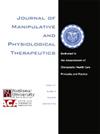疼痛感知中的指令和期望对瞳孔直径和疼痛认知评估的影响。
IF 1.4
4区 医学
Q4 HEALTH CARE SCIENCES & SERVICES
Journal of Manipulative and Physiological Therapeutics
Pub Date : 2024-07-01
DOI:10.1016/j.jmpt.2024.09.009
引用次数: 0
摘要
研究目的本研究旨在分析疼痛和无痛预期对瞳孔直径以及使用瞳孔测量法和视觉模拟量表(VAS)对疼痛进行认知评估的影响:这是一项实验性横断面研究,在 30 名健康参与者中,通过使用瞳孔测量仪触诊,对颌面部肌肉进行疼痛刺激。在疼痛刺激之前,通过教学视频诱发疼痛预期和无疼痛预期情况。认知和生理疼痛反应通过视觉模拟量表和瞳孔测量法进行测量。在每个实验条件结束时评估视觉模拟量表得分,在实验过程的不同时刻(事件)记录瞳孔测量结果:结果:与无疼痛预期相比,疼痛预期条件下所有事件的疼痛评分和更大的瞳孔直径(除了预期的初始基线)都具有统计学意义:结论:在本研究的条件下,疼痛预期对疼痛认知评估(VAS)和瞳孔直径都有调节作用。这些研究结果表明,瞳孔直径可能是一种有用的、与 VAS 相辅相成的疼痛评估工具。此外,研究结果还支持情感和认知是疼痛感知的重要方面这一假设模型,这与国际疼痛研究协会最近对疼痛的定义是一致的。本文章由计算机程序翻译,如有差异,请以英文原文为准。
Influence of Instructions and Expectations in Pain Perception on Pupil Diameter and the Cognitive Assessment of Pain
Objective
The purpose of this study was to analyze the influence of pain and no pain expectation on pupil diameter and the cognitive assessment of pain using pupillometry and the visual analog scale (VAS).
Methods
This was an experimental cross-sectional study in which painful stimulation of the muscle masseter was produced by palpation with an algometer in a sample of 30 healthy participants. Before the painful stimulation, pain expectation and no pain expectation situations were induced by employing instructional videos. Cognitive and physiological pain responses were measured by the VAS and by pupillometry. Visual analog scale score was assessed at the end of each experimental condition, and pupillometry measurements were recorded at different moments of the experimental process (events).
Results
The pain score and larger pupil diameter for all events (except, as expected, for the initial baseline), were statistically significant for the pain expectation condition compared with the no pain expectation.
Conclusion
Within the conditions of this study, pain expectation modulated both cognitive assessment of pain (VAS) and pupil diameter. These findings suggest that pupil diameter may be a useful and complementary tool with the VAS for pain assessment. Furthermore, the findings support models postulating that emotion and cognition are important aspects involved in pain perception, which is in line with the recent International Association for the Study of Pain definition of pain.
求助全文
通过发布文献求助,成功后即可免费获取论文全文。
去求助
来源期刊
CiteScore
3.00
自引率
7.70%
发文量
63
审稿时长
29 weeks
期刊介绍:
The Journal of Manipulative and Physiological Therapeutics (JMPT) is an international and interdisciplinary journal dedicated to the advancement of conservative health care principles and practices. The JMPT is the premier biomedical publication in the chiropractic profession and publishes peer reviewed, research articles and the Journal''s editorial board includes leading researchers from around the world.
The Journal publishes original primary research and review articles of the highest quality in relevant topic areas. The JMPT addresses practitioners and researchers needs by adding to their clinical and basic science knowledge and by informing them about relevant issues that influence health care practices.

 求助内容:
求助内容: 应助结果提醒方式:
应助结果提醒方式:


